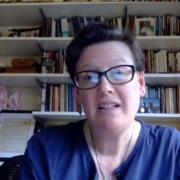A Video Message from Rabbi Rachel
[youtube https://www.youtube.com/watch?v=E-ZFNaIsiSY]
This short video begins with a check-in for the CBI community, and then moves to a teaching from the rabbi of the Warsaw Ghetto for this week’s parsha that feels especially meaningful to me this year. There’s a transcript below the video if you’d rather read it than watch it. Thinking of you all. – Rabbi Rachel
Shavua tov, friends: a good week to you. I hope that your Shabbat was restorative. As we enter into week six of sheltering-in-place and social distancing, I wanted to check in. How are you holding up?
I miss you. All of you. It’s been a joy to see some of you via Zoom at my drop-in office hours on Mondays, at the Psalm-writing class I’ve been teaching on Fridays, at Friday morning meditation and at Shabbat services. I look forward to continuing to see you on Zoom, or hearing your voices by phone, or receiving your emails and texts, since right now those are the modalities available to us.
Here’s a funny thing that I’m starting to think maybe isn’t a coincidence. At the start of the new Jewish year, back in October, both of my hevruta partners / learning buddies — Rabbi Megan Doherty, who’s the Jewish chaplain at Oberlin, and my colleagues on the board of Bayit: Building Jewish — felt called to study a rabbi known as the Piazeczyner, also known as R’ Kalman Kalonymus Shapiro, also known as the Aish Kodesh, also known as the rabbi of the Warsaw Ghetto.
The Piazeczyner was writing from the Warsaw Ghetto. In a time of profound fear and anxiety, deprivation and illness. And yet he found ways to cultivate hope, even in those terrible times.
This week’s Torah portion is Tazria-Metzora, which offers teachings about how to handle a particular kind of sickness that was observable both in people, and in their dwellings. Both human beings, and their homes, could become “contagious” and needed to be quarantined for a time.
Whoa, that resonates in a whole new way this year.
The scholar Rashi, who lived around the year 1000, says this teaching is really about treasure hidden in the walls of the houses of the Emorites, whom our ancient ancestors conquered when we moved into the promised land. The houses would be marked as having tzara’at, and then they would be demolished, and we would find treasure in them.
The Piazeczyner asks: if the point is that there’s treasure in the walls, why wait seven days? Why not just knock them down? His answer is this: because the waiting helps us cultivate faith that good things will come.
Even in a difficult time, he writes — “when there is no school for our children, no synagogue in which to pray in community with a minyan, no mikvah (ritual bath)” — even in a time like that (a time like this!), we need to trust that God can help us turn even the most difficult of circumstances into blessings. We never know, when something difficult is happening, what blessing we might be able to find in it later when we look back on it.
So as we stay quarantined, sheltering in place, socially distancing to protect the vulnerable from the spread of this awful disease: may we follow the advice of the Piazeczyner, and try to cultivate trust that there may be treasure in these difficult days.
Maybe it’s the treasure of knowing that we are protecting each other from illness. Maybe it’s the treasure of coming to recognize what really matters to us — even if what really matters to us is something that right now we can’t have.
May we live to emerge from this narrow place, and may we connect in person again: speedily and soon, with God’s help.
Thinking of you and sending blessings to all.
Cross-posted to Velveteen Rabbi. With special thanks to R’ David Markus for learning this with me on Shabbes. For those who want the original teaching, it’s the Aish Kodesh on M’tzora 1940 / 5700.






